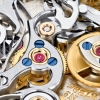-
Similar Content
-
Recently Browsing
- No registered users viewing this page.
-
Topics
-
Posts
-
I suppose? If it worked before and it doesn't work now I guess the question would be why does it not work now? That would come back to if you did not have the chronograph module on will it work or is the chronograph module sucking too much power out of the watch basically 99 usually when they go bad you can hold on the tube part and usually just spin the wheel because it has zero holding at all so usually when they go bad they go bad very bad. You should build hotel when you set the watch as to whether it seems to have any friction or not. I'm just wondering if the chronograph module is the problem.
-
Thinking about his DVDs I inherited one. Strangely enough I've never watched it. It does have a interesting picture on the cover though. Then at the link below it explains about the contents of the DVD. I assume the DVD covers the machine on the cover of the package and I see in the contents they even explain how to make a indexing if you don't have another indexing wheel to copy. https://wrsmithclocks.com/product/tooling-the-workshop-for-clockmakers-and-modelmakers/
-
Sorry, I should have been a bit clearer. I have had this watch for a long time and it previously stopped due to an obstruction in the train. Never had any issues with the cannon pinion until after the service.
-
ive got a 3220 dd module here that i go back to every now and then an it never works correctly , massive pain as i love the watch i that needs it!
-
I'm a little confused here before servicing everything was fine and now it's not? Then I'm assuming if you run it without the chronograph modular runs just fine or does it give you problems then? Then as far as tightening goes I've occasionally seen people use a staking set and sometimes it works sometimes it doesn't. You can also disassemble and flip it over that sometimes works. Otherwise try eBay and maybe one will come up. There is a tiny possibility if the Problem is on the gear part and not on the center tube that you could purchase a shorter version and pop it on your longer version that's a speculation on my part that may be that might work but if the tube itself is worn then you're going to have a problem then it's back to eBay and just try to find one in the first place all sorts of things will show up on eBay sooner or later.
-





Recommended Posts